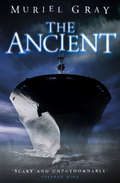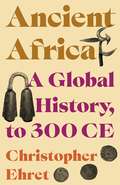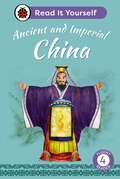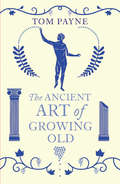- Table View
- List View
Ancestral Voices in Irish Politics: Judging Dillon and Parnell
by Prof Paul BewThe story of Charles Stewart Parnell, one of the greatest Irish leaders of the nineteenth century and also one of the most renowned figures of the 1880s on the international stage, and John Dillon, the most celebrated of Parnell's lieutenants. As Paul Bew shows, the differences between the two men reflect both Ireland's past and its future. The story of Charles Stewart Parnell, one of the greatest Irish leaders of the nineteenth century and also one of the most renowned figures of the 1880s on the international stage, and John Dillon, the most celebrated, but also the most neglected, of Parnell's lieutenants. As Paul Bew shows, the differences between the two men reflect both Ireland's past and its future. Every time the principle of consent for a united Ireland is discussed today, we can perceive the legacy of both men. Even more profoundly, that legacy can be seen when Irish nationalism tries to transcend a tribalist outlook based on the historic Catholic nation, even when the country is no longer so very Catholic.
The Ancestry of Regional Spatial Planning: A Planner’s Look at History
by Louis C. WassenhovenThis book is not a historical or archaeological treatise, but rather a study in which the author looks at the past, not as a historian, but as a planner who has the ambition to unravel the early manifestations of his discipline; a discipline which did not exist as such in remote periods, but the ingredients of which were nevertheless present. The author has observed the past equipped with knowledge and understanding of what regional planning was in the second half of the twentieth century and still is. He stands in the period of the first decades after the Second World War, which were the formative years of regional planning, and looks back at bygone ages. He discusses ideas and literature from the immediate post-war period in order to examine the ancestry of regional planning through their lens. The book will attract a broad range of readers because of its approach and its wide coverage of historical periods and world regions. Although Europe is the main focus, the book contains material on all continents and all periods, the ancient world, the medieval age and the modern era. The history of Urban Planning is taught and researched widely, but the history, or pre-history, before the twentieth century, of Regional Spatial Planning is not. This book will fill that vacuum.
The Anchoress: A Novel
by Robyn CadwalladerEngland, 1255: Sarah is only seventeen when she chooses to become an anchoress, a holy woman shut away in a small cell, measuring seven paces by nine, at the side of the village church. Fleeing the grief of losing a much-loved sister in childbirth and the pressure to marry, she decides to renounce the world, with all its dangers, desires and temptations, and to commit herself to a life of prayer and service to God. But as she slowly begins to understand, even the thick, unforgiving walls of her cell cannot keep the outside world away, and it is soon clear that Sarah's body and soul are still in great danger...Robyn Cadwallader's powerful debut novel tells an absorbing story of faith, desire, shame, fear and the very human need for connection and touch. With a poetic intelligence, Cadwallader explores the relationship between the mind, body and spirit in Medieval England in a story that will hold the reader in a spell until the very last page.
The Anchoress of Chesterfield: John the Carpenter (Book 4)
by Chris NicksonJohn the Carpenter has been happy to leave the investigation of death behind. For six years now he’s been content to work with wood. His life looks prosperous, but times are growing desperate. Then the coroner summons him to look at the mysterious death of an anchoress, a religious woman who lived in confined solitude. She’s been murdered. Her father is an important local landowner, a man of influence with the crown. He’s distraught, and the money he offers John to find the killer can solve his problems and leave his family comfortable for life. But the path to the truth leads John to the heart of the rich, and back into history, to places where he’s not welcome and in danger for his own life. Can he find the killer? And what will happen if he doesn’t?
Ancien Regime and the Revolution
by Alexis De Tocqueville Gerald BevanThe Ancien Régime and the Revolution is a comparison of revolutionary France and the despotic rule it toppled. Alexis de Tocqueville (1805–59) is an objective observer of both periods – providing a merciless critique of the ancien régime, with its venality, oppression and inequality, yet acknowledging the reforms introduced under Louis XVI, and claiming that the post-Revolution state was in many ways as tyrannical as that of the King; its once lofty and egalitarian ideals corrupted and forgotten. Writing in the 1850s, Tocqueville wished to expose the return to despotism he witnessed in his own time under Napoleon III, by illuminating the grand, but ultimately doomed, call to liberty made by the French people in 1789. His eloquent and instructive study raises questions about liberty, nationalism and justice that remain urgent today.
Ancient Aesthetics
by Andrew MasonAncient thought, particularly that of Plato and Aristotle, has played an important role in the development of the field of aesthetics, and the ideas of ancient thinkers are still influential and controversial today. Ancient Aesthetics introduces and discusses the central contributions of key ancient philosophers to this field, carefully considering their theories regarding the arts, especially poetry, but also music and visual art, as well as the theory of beauty more generally. With a focus on Plato and Aristotle, the philosophers who have given us their thought about the arts at the greatest length, this volume also discusses Hellenistic aesthetics and Plotinus’ theory of beauty, which was to prove very influential in later thought. Ancient Aesthetics is a valuable contribution to its field, and will be of interest to students of philosophy and classics.
Ancient Aesthetics
by Andrew MasonAncient thought, particularly that of Plato and Aristotle, has played an important role in the development of the field of aesthetics, and the ideas of ancient thinkers are still influential and controversial today. Ancient Aesthetics introduces and discusses the central contributions of key ancient philosophers to this field, carefully considering their theories regarding the arts, especially poetry, but also music and visual art, as well as the theory of beauty more generally. With a focus on Plato and Aristotle, the philosophers who have given us their thought about the arts at the greatest length, this volume also discusses Hellenistic aesthetics and Plotinus’ theory of beauty, which was to prove very influential in later thought. Ancient Aesthetics is a valuable contribution to its field, and will be of interest to students of philosophy and classics.
Ancient Africa: A Global History, to 300 CE
by Distinguished Re Christopher EhretA panoramic narrative that places ancient Africa on the stage of world historyThis book brings together archaeological and linguistic evidence to provide a sweeping global history of ancient Africa, tracing how the continent played an important role in the technological, agricultural, and economic transitions of world civilization. Christopher Ehret takes readers from the close of the last Ice Age some ten thousand years ago, when a changing climate allowed for the transition from hunting and gathering to the cultivation of crops and raising of livestock, to the rise of kingdoms and empires in the first centuries of the common era.Ehret takes up the problem of how we discuss Africa in the context of global history, combining results of multiple disciplines. He sheds light on the rich history of technological innovation by African societies—from advances in ceramics to cotton weaving and iron smelting—highlighting the important contributions of women as inventors and innovators. He shows how Africa helped to usher in an age of agricultural exchange, exporting essential crops as well as new agricultural methods into other regions, and how African traders and merchants led a commercial revolution spanning diverse regions and cultures. Ehret lays out the deeply African foundations of ancient Egyptian culture, beliefs, and institutions and discusses early Christianity in Africa.A monumental achievement by one of today’s eminent scholars, Ancient Africa offers vital new perspectives on our shared past, explaining why we need to reshape our historical frameworks for understanding the ancient world as a whole.
Ancient African Christianity: An Introduction to a Unique Context and Tradition
by David E. WilhiteChristianity spread across North Africa early, and it remained there as a powerful force much longer than anticipated. While this African form of Christianity largely shared the Latin language and Roman culture of the wider empire, it also represented a unique tradition that was shaped by its context. Ancient African Christianity attempts to tell the story of Christianity in Africa from its inception to its eventual disappearance. Well-known writers such as Tertullian, Cyprian, and Augustine are studied in light of their African identity, and this tradition is explored in all its various expressions. This book is ideal for all students of African Christianity and also a key introduction for anyone wanting to know more about the history, religion, and philosophy of these early influential Christians whose impact has extended far beyond the African landscape.
Ancient African Christianity: An Introduction to a Unique Context and Tradition
by David E. WilhiteChristianity spread across North Africa early, and it remained there as a powerful force much longer than anticipated. While this African form of Christianity largely shared the Latin language and Roman culture of the wider empire, it also represented a unique tradition that was shaped by its context. Ancient African Christianity attempts to tell the story of Christianity in Africa from its inception to its eventual disappearance. Well-known writers such as Tertullian, Cyprian, and Augustine are studied in light of their African identity, and this tradition is explored in all its various expressions. This book is ideal for all students of African Christianity and also a key introduction for anyone wanting to know more about the history, religion, and philosophy of these early influential Christians whose impact has extended far beyond the African landscape.
Ancient African Religions: A History
by Robert M. BaumScholars have sometimes maintained that the study of the history of African religions is an impossible endeavor. Some have contended that African religions do not have a history unto themselves, apart from their interaction with the newer religious traditions of Islam and Christianity. Others concede that such a history exists, but believe the source materials are insufficient to reconstruct such a history. This book speaks directly to these critics. The history of African religions becomes in many ways like a pentathlon, expecting the scholar who conducts such research to work with written texts, to learn African languages, to live within a community where these religious traditions are practiced, to study material culture, both sacred and mundane, and a variety of archaeological sources from tree rings to stone circles and gravesites. By relying on the existing corpus of written texts, oral traditions, linguistic analyses, descriptions based on participant observation, and various types of archaeology, Robert M. Baum demonstrates that African religious history is nearly as old as humanity itself. Baum has spent his entire academic career focused on the historical study of African religious traditions, as far back as accessible sources will permit. This volume traces the history of African religions beginning with early hominids and their ritual and burial sites through ancient Egypt, North and Northeast Africa, and Africa south of the Sahara from the Fourth Millennium BCE to the birth of Islam in the Seventh Century.
Ancient African Religions: A History
by Robert M. BaumScholars have sometimes maintained that the study of the history of African religions is an impossible endeavor. Some have contended that African religions do not have a history unto themselves, apart from their interaction with the newer religious traditions of Islam and Christianity. Others concede that such a history exists, but believe the source materials are insufficient to reconstruct such a history. This book speaks directly to these critics. The history of African religions becomes in many ways like a pentathlon, expecting the scholar who conducts such research to work with written texts, to learn African languages, to live within a community where these religious traditions are practiced, to study material culture, both sacred and mundane, and a variety of archaeological sources from tree rings to stone circles and gravesites. By relying on the existing corpus of written texts, oral traditions, linguistic analyses, descriptions based on participant observation, and various types of archaeology, Robert M. Baum demonstrates that African religious history is nearly as old as humanity itself. Baum has spent his entire academic career focused on the historical study of African religious traditions, as far back as accessible sources will permit. This volume traces the history of African religions beginning with early hominids and their ritual and burial sites through ancient Egypt, North and Northeast Africa, and Africa south of the Sahara from the Fourth Millennium BCE to the birth of Islam in the Seventh Century.
Ancient Americans
by SchobingerLavishly illustrated in full color and black and white, this handsome reference provides a broad survey of the rich artistic heritage of pre-Columbian North and South America. Meticulously researched by archaeologists and anthropologists, the set features dramatic close-ups of engraved rock artifacts, cave paintings, pottery, and inscribed and sculpted bones. Covering the entire two continents from present-day Canada in the far north through Central America and down to the Andes Mountains and Patagonia in the south, it is a stunning visual and written record of the great variety of artworks created by Neolithic American peoples over many millennia.
Ancient Americans
by SchobingerLavishly illustrated in full color and black and white, this handsome reference provides a broad survey of the rich artistic heritage of pre-Columbian North and South America. Meticulously researched by archaeologists and anthropologists, the set features dramatic close-ups of engraved rock artifacts, cave paintings, pottery, and inscribed and sculpted bones. Covering the entire two continents from present-day Canada in the far north through Central America and down to the Andes Mountains and Patagonia in the south, it is a stunning visual and written record of the great variety of artworks created by Neolithic American peoples over many millennia.
Ancient and Early Medieval Kingdoms of the Pamir Region of Central Asia: Historical Shughnān and its Lost Capital
by Muzaffar Zoirshoevich ZoolshoevThis focused study is one of the few analytical resources in English that covers the ancient and early medieval history of one of the least studied areas of the vast mountainous Pamir region of Central Asia: Shughnān. The book brings together scattered fragments of information from a wide range of early Greek, Chinese, Persian, and Arabic sources, the accounts of early European travellers and the scholarly contributions of Soviet and post-Soviet authors, as well as personal accounts and oral history material from the region. Drawing on historical, archaeological, linguistic, and ethnographic data, it provides a holistic overview of the kingdom of Shughnān. It also attempts, for the first time, to identify and locate the town of Kǔhán, which the Chinese historical chronicle, the Táng Shū (Book of the Tang Dynasty, 618–907 CE) describes as the ‘first capital’ of Shughnān. Many archaeological sites are examined and offered as potential candidates for the location of the town of Kǔhán, providing a foundation for future archaeological and ethnolinguistic research in the area. Ancient and Early Medieval Kingdoms of the Pamir Region of Central Asia: Historical Shughnān and its Lost Capital is suitable for students, scholars, and historians studying ancient and early medieval Central Asia, particularly the Pamir region, as well as those interested in Central Asian history and archaeology more broadly.
Ancient and Early Medieval Kingdoms of the Pamir Region of Central Asia: Historical Shughnān and its Lost Capital
by Muzaffar Zoirshoevich ZoolshoevThis focused study is one of the few analytical resources in English that covers the ancient and early medieval history of one of the least studied areas of the vast mountainous Pamir region of Central Asia: Shughnān. The book brings together scattered fragments of information from a wide range of early Greek, Chinese, Persian, and Arabic sources, the accounts of early European travellers and the scholarly contributions of Soviet and post-Soviet authors, as well as personal accounts and oral history material from the region. Drawing on historical, archaeological, linguistic, and ethnographic data, it provides a holistic overview of the kingdom of Shughnān. It also attempts, for the first time, to identify and locate the town of Kǔhán, which the Chinese historical chronicle, the Táng Shū (Book of the Tang Dynasty, 618–907 CE) describes as the ‘first capital’ of Shughnān. Many archaeological sites are examined and offered as potential candidates for the location of the town of Kǔhán, providing a foundation for future archaeological and ethnolinguistic research in the area. Ancient and Early Medieval Kingdoms of the Pamir Region of Central Asia: Historical Shughnān and its Lost Capital is suitable for students, scholars, and historians studying ancient and early medieval Central Asia, particularly the Pamir region, as well as those interested in Central Asian history and archaeology more broadly.
Ancient and Imperial China: Read It Yourself - Level 4 Fluent Reader (Read It Yourself)
by LadybirdDiscover the Terracotta Army, the Silk Road and the great inventions of China - from paper and porcelain to fireworks and acupuncture.Ancient and Imperial China is from Fluent Reader Level 4. It is ideal for children aged 7+ who can confidently read texts with a wider vocabulary, and who are beginning to read longer stories by themselves.Read It Yourself is a series of modern stories, traditional tales and first reference books for children who are learning to read.Each book has been carefully checked by educational consultants and includes comprehension puzzles, book band information, and tips for helping children with their reading.With five levels to take children from first phonics to fluent reading, Read It Yourself helps every child on their journey to becoming a confident reader.
Ancient and Medieval Thought on Greek Enclitics
by Stephanie Roussou Philomen ProbertThis book has two complementary aims: to improve our grasp of the ideas about Greek enclitics that ancient and medieval scholars have passed down to us, and to show how a close examination of these sources yields new answers to questions concerning the facts of the ancient Greek language itself. New critical editions of the most extensive surviving ancient and medieval texts on Greek enclitics, together with translations into English, lay the foundations for an improved understanding of thought on Greek enclitics in those periods. Stephanie Roussou and Philomen Probert then draw out the main doctrines and the conceptual apparatus and metaphors that were used to think and talk about enclitic accents, consider the antiquity of these ideas within the Greek grammatical tradition, and make use of both ancient and medieval sources to explore two much-debated questions about the facts of the language itself. Firstly, the Greek sources turn out to shed new light first of all on the circumstances under which enclitic ἐsτί was used and the circumstances under which non-enclitic ἔsτι appeared. Secondly, ancient and medieval evidence from several directions comes together in a way that has gone unnoticed until now, and suggests a new answer to the question of how sequences of consecutive enclitics were accented in antiquity.
Ancient and Medieval Thought on Greek Enclitics
by Stephanie Roussou Philomen ProbertThis book has two complementary aims: to improve our grasp of the ideas about Greek enclitics that ancient and medieval scholars have passed down to us, and to show how a close examination of these sources yields new answers to questions concerning the facts of the ancient Greek language itself. New critical editions of the most extensive surviving ancient and medieval texts on Greek enclitics, together with translations into English, lay the foundations for an improved understanding of thought on Greek enclitics in those periods. Stephanie Roussou and Philomen Probert then draw out the main doctrines and the conceptual apparatus and metaphors that were used to think and talk about enclitic accents, consider the antiquity of these ideas within the Greek grammatical tradition, and make use of both ancient and medieval sources to explore two much-debated questions about the facts of the language itself. Firstly, the Greek sources turn out to shed new light first of all on the circumstances under which enclitic ἐsτί was used and the circumstances under which non-enclitic ἔsτι appeared. Secondly, ancient and medieval evidence from several directions comes together in a way that has gone unnoticed until now, and suggests a new answer to the question of how sequences of consecutive enclitics were accented in antiquity.
Ancient and Modern Approaches to the Problem of Relativism: A Study of Husserl, Locke, and Plato (Recovering Political Philosophy)
by Matthew K. DavisRelativism, or the claim that it is possible that the appearances and opinions of each of us are correct for each of us, and hence that any view is as true as any other, has remained a continuing problem for philosophy and science for 2,500 years. Today, because of the widespread acceptance of relativism, the problem is greater than ever before. This book argues that Plato in fact solved this problem. In the first two chapters, by means of a study of Husserl and Locke, Davis shows that it is possible to return to and take seriously Plato’s treatment of this problem. The third chapter presents Plato’s solution to it. This book is distinctive in that it shows that a problem that has been thought to be present throughout the history of Western thought was in fact solved by Plato, and in that it shows that we can, beginning from our contemporary situation, return to Plato’s solution.
Ancient Anger: Perspectives from Homer to Galen (PDF)
by Editors Susanna Braund Glenn W. MostAnger is found everywhere in the ancient world, starting with the very first word of the Iliad and continuing through all literary genres and every aspect of public and private life. Yet it is only recently, as a variety of disciplines start to devote attention to the history and nature of the emotions, that Classicists, ancient historians and ancient philosophers have begun to study anger in antiquity with the seriousness and attention it deserves. This volume brings together a number of significant studies by authors from different disciplines and countries, on literary, philosophical, medical and political aspects of ancient anger from Homer until the Roman Imperial Period. It studies some of the most important ancient sources and provides a paradigmatic selection of approaches to them, and should stimulate further research on this important subject in a number of fields.
The Ancient Art of Growing Old
by Tom PayneBette Davis said ‘Old age ain’t no place for sissies’. If that’s true, we could all use a little help as we approach our twilight years. Translator Tom Payne turns to Ovid, Seneca, Hippocrates, Plato, Aristotle, and Aristophanes to discover invigorating counsel on mental decline, medicine, late love affairs, death and legacy. This lively tour of ancient attitudes to ageing, supplemented by a translation of Cicero’s ‘On Old Age’, reveals the true art of growing old gracefully.


















